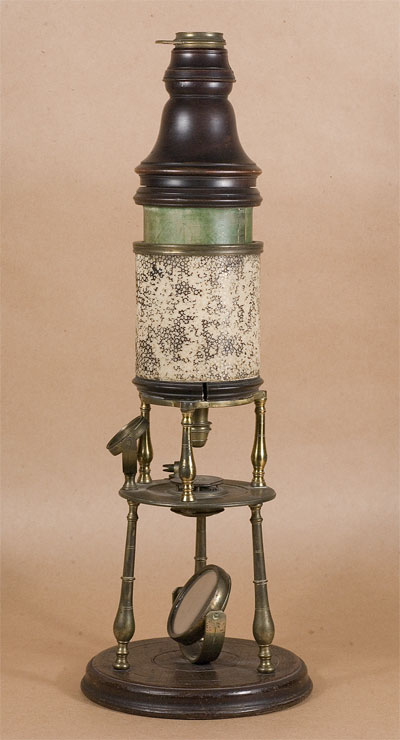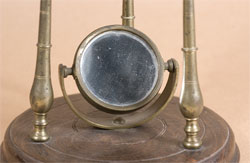 |
|||||
 |
 |
||||
 |
|||||
 |
 |
||||
Culpeper Double Reflecting Microscope (#78) |
|||||||||||||||
 |
|||||||||||||||
| Age: 1735–1738 Made by: Edmund Culpeper Made in: England |
|||||||||||||||
 |
|||||||||||||||
|
Culpeper's signature
|
|||||||||||||||
 |
|||||||||||||||
|
Culpeper was the first to use a concave mirror placed in the optical path to illuminate the sample.
|
|||||||||||||||
 |
|||||||||||||||
|
Flyer describing the Culpeper microscope.
|
|||||||||||||||
|
This is an example of the famous microscope by the Englishman, Edmund Culpeper (c1670–1738). Culpeper invented the tripod compound microscope sometime between 1725 and 1730, and made at least five major modifications in the years before his death. All models consisted essentially of two platforms, each supported by three turned brass pillars, with one set of pillars alternating in position with the other. The first model had platforms of wood. All later models, including this one, had brass platforms. Attached to the upper platform is a cardboard tube covered in stained shagreen (black in this case). The microscope body, which is made also of a cardboard tube but covered in vellum (here dyed green), fits within the outer support tube. Focusing is accomplished by pushing the body tube up or down, with the position being maintained by friction between the vellum covering of the body tube and the inner surface of the support tube. On some Culpeper models there are numbered lines or dots on the body tube corresponding to the parfocal position of different objectives. This instrument in the Golub Collection has no obvious body tube markings. Optics consist of three lens systems: the eyepiece, field lens, and objective. In this instrument the field lens consists of a wooden tube with two lenses fixed to the ends. This "field tube" is located inside the microscope body centered on the optic axis. It is unknown whether other Culpeper tripod microscopes have this two-lens field tube. The single, bi-convex eyepiece lens was mounted at the top of the wooden cap piece, but is missing in this instrument. Culpeper microscopes were usually supplied with five objectives, however there is only one remaining with this instrument. It is marked with a single notch. The objective is screwed onto the end of a tapered brass nosepiece ("snout"), which protrudes through a hole in the upper brass platform. Imaging is not possible with this instrument due to the missing eyepiece lens. Sample illumination is via a Culpeper invention—the substage concave mirror—or from above (for opaque samples) via a bull's-eye lens. The circular stage has a recessed central opening (characteristic of later Culpeper models) and a spring-loaded specimen holder. Below the stage is a threaded brass extension that would have been used to control the angle of transmitted light from the mirror. The sample platform has a mount for a fish-plate and/or forceps (missing from this instrument). The microscope sits on a circular Lignum vitae base 13cm in diameter. The complete microscope is approximately 36cm in height. The exact date of construction of this instrument is not known, but its features suggest this is a later model (No. 4 or 5) made between 1735 and 1738. This instrument has an oak pyramidal case with a single drawer at the bottom (now missing). Inside the case is the distinctive Culpeper trade card. In Culpeper's era, opticians would advertise their wares via a business, or trade card. Edmund Culpeper adopted the Crossed Daggers motif of Walter Hayes*, to whom he was apprenticed in 1684. In 1706 Culpeper took over Hayes' shop located at "The Crossed Daggers" in Moorfields London. In 1731 Culpeper moved his shop to the "Black & White House" in Middle Moorfields. The Culpeper trade card showed instruments made by his firm. These included surveying devices, quadrants, sundials, globes, and optical instruments such as the screw-barrel microscope and spectacles. The latest contemporary reference to Culpeper is 1738**. He went out of business or died c1740. The construction materials—Lignum vitae, brass and vellum- or shagreen-covered cardboard—were chosen because they were inexpensive and uniform in shape and size. The method for making precision brass draw tubes had not yet been invented, so friction-focusing using brass would not have been possible at that time. Culpeper chose also to not include screw-thread focusing, as is found in Marshall-type microscopes, because it would have increased the cost of the instrument. Culpeper created an instrument that was low cost, functional, and beautiful, thus many of these microscopes were sold, and many remain to this day. *Walter Hayes made high-quality scientific instruments from 1651–1692. He was particularly well known for his surveying quadrants and sundials. **Clay, RS, and TH Court. 1932. The History of the Microscope. The reference is in a pamphlet describing a Culpeper-made Hadley's Quadrant. |
|||||||||||||||
| Microscope featured 4/04 & 2/08 | |||||||||||||||